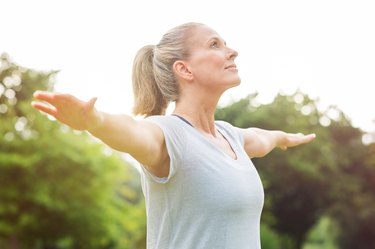
If you have arthritis, going for a jog may seem like it would do your joints more harm than good. But as counterintuitive as it seems, physical activity may be just what the doctor ordered.
About 54 million people in the U.S. have been diagnosed with arthritis, an inflammatory condition that causes joint pain and swelling.
These symptoms can also prevent people from exercising: Arthritis statistics show almost 24 percent of people with the condition don't do any physical activity (compared to about 18 percent of those without arthritis), according to the Centers for Disease Control and Prevention (CDC).
"In general, people with arthritis tend to want to take it easy or not exercise as much," Brian Andonian, MD, a rheumatologist and assistant professor of medicine at Duke University School of Medicine, tells LIVESTRONG.com. "But exercise, done right, is probably one of the most beneficial things they can do to help their joints."
Osteoarthritis, the most common type of arthritis in the U.S., occurs when the cartilage surrounding the ends of bones (such as those of the knees and hands) break down — which is partly why it's known as "wear and tear" arthritis. But in some ways, that definition can be misleading.
"The 'wear and tear' component is really much more specific," says Joseph Garry, MD, a visiting professor of clinical family medicine at the University of Illinois College of Medicine Rockford. "It's not so much moving or exercising."
Rather, he explains, osteoarthritis can be caused by overloading the joint, by being overweight, maybe, or by carrying lots of heavy objects at work. Joint injuries, such as those sustained by playing a sport, may also increase the risk for osteoarthritis, he says.
Exercise, however, can help ease pain from osteoarthritis as well as from other inflammatory types of arthritis, including rheumatoid and psoriatic arthritis, says Dr. Andonian.
Ready to get started? Here's a closer look at why exercise is so beneficial for people with arthritis, and how to start working out safely.
Related Reading
Why Exercise Is Good for Arthritis
Exercise can reduce pain, improve joint function and boost the quality of life of people with arthritis, according to the CDC.
One early investigation into exercise and arthritis, published January 2008 in the journal Arthritis & Rheumatism, found that people with arthritis who participated in an exercise program felt less pain and fatigue at the end of eight weeks than those who didn't work out. Plus, they continued to feel less pain and fatigue six months later.
Newer research has confirmed those findings, concluding that even short periods of activity can help prevent joint pain from worsening. In a study published May 2019 in the American Journal of Preventive Medicine, people with joint pain who performed one hour of moderate-to-vigorous activity a week were less likely to develop a disability after four years as those who weren't as active.
"Any exercise for somebody with arthritis who's sedentary is going to be helpful. Every little bit adds up, even a few minutes here and there."
Exercise can help ease joint pain in a few ways, says Dr. Andonian. For starters, he says, physical activity can strengthen the muscles that surround the joint, which helps take some of the pressure off the joint itself. It also helps you sleep better, which can also help ease pain.
Another way exercise can help ease arthritis symptoms is by lowering the levels of inflammation in the body, which is a characteristic of arthritis, he says.
"I think of exercise as being an anti-inflammatory treatment," says Dr. Andonian. "We know that exercise has pretty powerful ways of [regulating] the way the immune system works."
Specifically, he explains, fat is more pro-inflammatory than lean muscle mass, which tends to be more anti-inflammatory and beneficial for arthritis.
The Best Types of Exercise for Arthritis

Because both aerobic exercise and strength training improve body composition, doing either one — and ideally both — can help improve arthritis symptoms, Dr. Andonian says.
Other types of activity that you may want to try include range-of-motion and body awareness exercises, according to the American College of Rheumatology.
Here are some examples of these four main types of exercise, plus good options for people with arthritis:
1. Aerobic (Cardio)
2. Strength Training
- Body-weight exercises
- Weight lifting
- Resistance band exercises
Related Reading
3. Range-of-Motion Exercises
- Stretching
- Yoga
- Tai chi
4. Body Awareness Workouts
- Balance exercises
- Tai chi
- Yoga
If you're just starting an exercise program, one of the best things you can do is commit to an activity that you like to do, and one that's also compatible with your schedule and lifestyle.
"Keeping up a program in the long-term has got to be enjoyable," Dr. Andonian says.
The CDC recommends adults get at least 150 minutes of moderate-intensity aerobic exercise or 75 minutes of vigorous exercise each week, but if you haven't been exercising very much (if at all), try working up to that goal slowly, over time, says Dr. Andonian.
"Any exercise for somebody with arthritis who's sedentary is going to be helpful," he says. "Every little bit adds up, even a few minutes here and there."
Are There Any Risks to Exercising With Arthritis?
Before you start a new exercise program, it's a good idea to let your doctor know what you're doing, says Dr. Andonian. Your provider may be able to refer you to another health care professional, like a physical therapist, who can design a workout plan for you and even help coach you through the movements.
After you start exercising, you'll probably feel some stiffness or swelling, possibly for six to eight weeks, according to the CDC. But that's OK.
"A little bit of soreness isn't necessarily a bad thing, especially if you're starting to get some gains over time," Dr. Andonian says.
That said, you may want to modify certain exercises to make them more comfortable for you, he says. For example, if you have knee osteoarthritis, you can try starting a walking program, but avoid climbing a lot of hills. Or, if you want to try cycling but have arthritis in your spine or hip, he recommends sitting on a bike in a reclined position, which can be more comfortable.
Even if you're having a flare-up of arthritis, it's still a good idea to try to do some exercise.
"A lot of people just completely stop all activities," he says. "I recommend that people try to stay active as much as they can within their comfort zone, even just doing light activities like range-of-motion type exercises."
If you happen to feel any sharp, stabbing and constant pain, pain that causes you to limp or pain in your joints that are red or feel "hot," the CDC recommends calling your doctor.
Is this an emergency? If you are experiencing serious medical symptoms, please see the National Library of Medicine’s list of signs you need emergency medical attention or call 911.